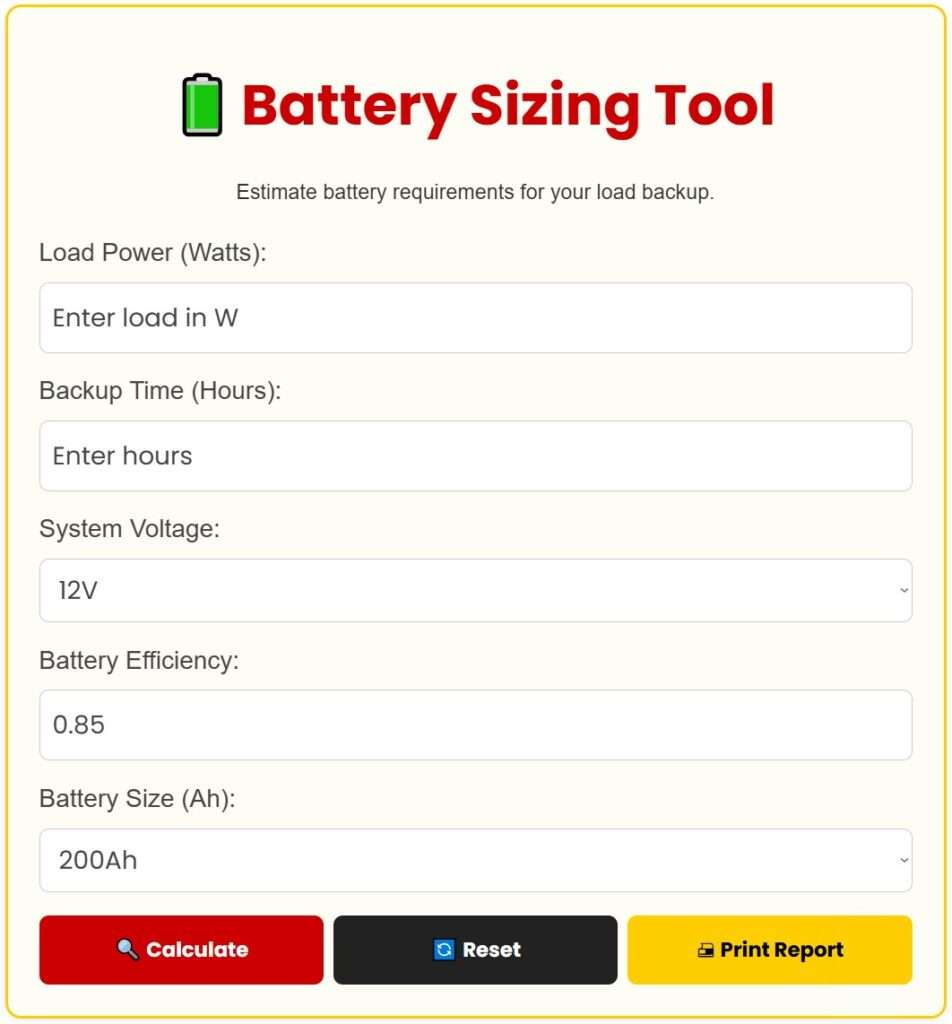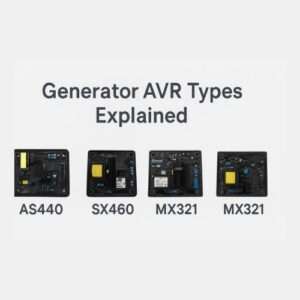🔋 Battery Sizing Tool:Calculate the perfect battery capacity for your solar system, UPS, inverter, or generator backup with our free Battery Sizing Tool. Quickly estimate battery Ah rating, backup hours, and load requirements to ensure reliable power and longer battery life. Ideal for home, office, and industrial users in Pakistan, this tool helps you choose the right battery setup for uninterrupted power and energy efficiency.
In a world increasingly reliant on uninterrupted power, understanding how to properly size your battery bank is no longer just for off-grid enthusiasts – it’s a fundamental skill for anyone seeking reliable backup power. From crucial medical equipment to home office setups, security systems, or remote cabins, knowing precisely how much battery capacity you need can mean the difference between seamless operation and frustrating downtime. This guide will walk you through the complexities of battery sizing, demystifying the calculations and introducing you to an invaluable Battery Sizing Tool that simplifies the entire process. No more guesswork, no more under-specifying, and certainly no more overspending on excessive capacity.To find new batteries you can also visit here.
We’ll cover everything from the basic principles of electrical load to the often-overlooked factors like battery efficiency and depth of discharge. By the end of this comprehensive article, you’ll not only understand the “why” behind each calculation but also have a powerful, easy-to-use battery bank calculator at your fingertips to provide accurate results instantly.

Why Accurate Battery Sizing is Critical for Backup Power
The phrase “better safe than sorry” often leads people to simply buy the largest battery they can afford. However, this isn’t always the most efficient or cost-effective approach. Accurate battery sizing is about balance: providing enough energy for your required backup time without incurring unnecessary expense or creating an oversized, inefficient system.
An undersized battery bank will fail prematurely, leaving you without power when you need it most. This can be critical for essential loads. For instance, imagine a vital medical device suddenly losing power due to an underestimated battery requirement. Beyond critical applications, even for everyday conveniences, an insufficient battery bank leads to frustration and potential damage to connected electronics due to repeated deep discharges. If your batteries are constantly being pushed beyond their limits, their lifespan will dramatically shorten, leading to costly replacements far sooner than anticipated.
This rapid degradation not only impacts your wallet but also the reliability of your entire system. The stress of frequent deep cycling can warp battery plates, reduce electrolyte effectiveness, and even lead to dangerous internal short circuits. Therefore, understanding your precise energy needs is the first step towards a robust and long-lasting backup solution.
Conversely, an oversized system, while offering ample power, carries its own set of disadvantages. Larger battery banks require more space, weigh more, and cost significantly more upfront. This additional investment might be entirely unnecessary if your actual energy consumption is much lower than your system’s capacity. Furthermore, excessively large battery banks that are consistently underutilized can sometimes suffer from different forms of degradation, such as sulfation, if they are rarely brought to a full charge cycle. Finding that sweet spot where capacity meets demand is key to both economic efficiency and operational longevity.
The goal is to provide reliable power for the intended duration without any wasted investment or space. This precise matching of capacity to need ensures that every dollar spent on your battery bank contributes directly to its performance and lifespan, making your investment truly worthwhile.
The Hidden Costs of Poor Battery Sizing
Beyond the obvious financial implications, poor battery sizing can lead to:
- Reduced Battery Lifespan: Both consistent under-cycling (for certain battery types) and frequent deep-cycling severely shorten battery life.
- System Instability: Fluctuating voltage and unreliable power delivery can damage sensitive electronics.
- Increased Maintenance: Overworked batteries require more frequent checks and can lead to early failure.
- Wasted Resources: Manufacturing, transporting, and disposing of unnecessarily large batteries impacts environmental sustainability.
Our Battery Sizing Tool aims to eliminate these risks by providing precise calculations based on your specific requirements.

Understanding the Fundamentals: Watts, Hours, Volts, and Amps
Before diving into the calculator, it’s essential to grasp the basic electrical units that form the bedrock of battery sizing.
- Watts (W): This is the unit of power, representing the rate at which electrical energy is consumed or produced. When you look at an appliance, its power consumption is usually listed in Watts. This is your “Load Power.”
- Hours (h): This is your “Backup Time,” the duration for which you need your battery system to supply power.
- Watt-hours (Wh): This unit represents total energy. It’s simply Watts multiplied by Hours. If you run a 100W light bulb for 10 hours, you’ve used 1000 Wh of energy.
- Volts (V): This is the electrical potential difference or “pressure” of your system. Common battery system voltages include 12V, 24V, and 48V. Matching your system voltage to your inverter and charge controller is crucial.
- Amperes (A) or Amps: This is the unit of electrical current, representing the flow rate of electricity.
- Amp-hours (Ah): This is the unit used to rate a battery’s capacity. A 100Ah battery can theoretically deliver 100 Amps for one hour, or 1 Amp for 100 hours. This is the key metric our Battery Sizing Tool will help you determine.
Understanding these terms is your first step towards becoming proficient in how to size batteries effectively. They form the core inputs that the battery bank calculator uses to deliver accurate results.
Introducing the Battery Sizing Tool: Your Personal Backup Power Calculator
Our Battery Sizing Tool is designed for simplicity and accuracy. It takes your real-world needs and converts them into precise battery specifications. Here’s how it works and the inputs it requires:
1. Load Power (Watts)
This is the total power consumption of all the devices you want to run from your battery bank.
- Input: Enter the sum of the wattage of all your appliances. For example, if you have a 100W laptop, a 50W fan, and a 20W light, your total load would be 170W.
- Tip: Always consider peak loads. If an appliance has a surge power (e.g., a refrigerator motor starting up), account for that, especially if it runs concurrently with other high-draw devices.
- Example: For a typical home office backup, you might sum up your computer, monitor, router, and a few lights.
2. Backup Time (Hours)
This is how long you need your battery system to provide power without recharging.
- Input: Enter the desired duration in hours.
- Consideration: Think realistically about your needs. Is it for short power outages (2-4 hours), overnight backup (8-12 hours), or extended off-grid periods (24+ hours)? This dramatically affects the required battery capacity.
- Example: For an average power outage scenario, 4 hours might be sufficient, but for an off-grid cabin, you might plan for 24-48 hours.
3. System Voltage (V)
This is the operating voltage of your entire battery system, determined by your inverter and charge controller.
- Input: Select 12V, 24V, or 48V from the dropdown.
- Importance: Higher voltage systems generally allow for thinner wires and more efficient power transfer, especially over longer distances or for higher power loads. Most small systems start at 12V, while larger home backup systems often use 24V or 48V.
- Recommendation: Match this to your inverter and charge controller specifications.
4. Battery Efficiency
Batteries are not 100% efficient; some energy is always lost during charging and discharging.
- Input: Our tool defaults to 85% (0.85), which is a common real-world efficiency for lead-acid batteries. You



